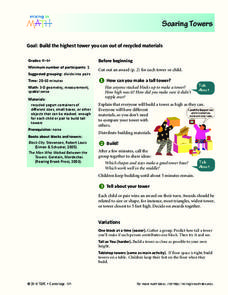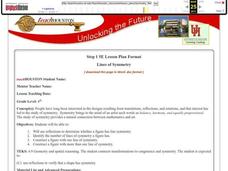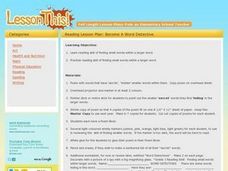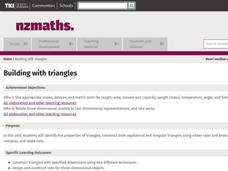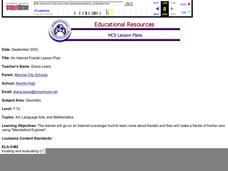Curated OER
Soaring Towers
Students build towers from recycled materials. in this building lesson, students build the highest tower they can from varied materials. They focus on shapes and which items should go on the bottom to make a strong base.
Curated OER
Imaginary Spaces: Designing a Play Space
Students apply their enthusiasm for imaginary play to create their own imaginary play space. In this novice architectural design lesson, students arrange and glue pre-cut foam shapes to a cardboard base to set up their play space. In...
Curated OER
Fly, Fly Away
Students use materials from their own environment to design a kite. In this kite design lesson, students research the history of kites and obtain a formal mathematical definition of a kite. Students sketch kite designs after discovering...
Curated OER
A Shapely Activity
Fifth graders explore polygons in various shape activities. In this polygons lesson, 5th graders discuss and identify polygons by their number of sides. Students sort ceramic tiles by the number of sides on each piece. Students explore...
Curated OER
Lines of Symmetry
Fourth graders identify lines of symmetry using reflections and then construct figures that have one or more lines of symmetry. In this symmetry lesson plan, 4th graders use sets of shapes, pattern blocks, a mirror, and more.
Curated OER
Become a Word Detective
Students investigate the origin of words in the English language. In this language history lesson, students examine words by breaking them down and finding their roots. Students analyze words from a poem and complete a word...
Curated OER
Describing an Object's Position
Learners explore language arts by participating in a shape identification activity. In this geometry shape lesson, students discuss the vocabulary terms used to describe the location of an object. Learners complete a worksheet based upon...
Curated OER
Building With Triangles
Fourth graders use two different techniques to construct triangles with specific dimensions. They determine how to construct nets for three-dimensional objects focusing on those made with equilateral triangles. They are able to name the...
Curated OER
Shapes
Fifth graders explore shapes. They recognize and name two-dimensional and three-dimensional shapes. Pupils discuss the properties and criteria for each shape they find in real life and construct a Kid Pix project using pictures of the...
Curated OER
Shape Hunt
Explore the world of shapes! After free tangram exploration and pair share time, learners describe various patterns and shapes in both the natural and designed world. They investigate the use of tangrams to create patterns and shapes.
Curated OER
Tantalizing Tessellations Lesson III: Creating a Slide Translation
Students watch and discuss an M. C. Escher video, use what they have learned to explain and apply their knowledge of tessellations in order to create a slide translation, present their findings in a 12" x 18" poster, and explore...
Curated OER
Tantalizing Tessellations - Lesson I
Middle schoolers complete a chart (KWL) as a pre-assessment, study the history of tessellations (tilings), investigate the properties of tessellations, and make and evaluate photographs of "found tessellations" for a...
Curated OER
Geometry: Fractal Scavenger Hunt
Students experience an Internet fractal scavenger hunt. They write a report on fractals using the Internet and recording the sites where they are located.
Curated OER
Geometry: Classifying Angles
Students measure, construct, and classify angles as acute, right, straight, and obtuse. Once they have completed an angle worksheet, students use a map of South Carolina to locate cities by constructing the aforementioned angles.
Curated OER
Animals, Animals, Everywhere
Fourth graders participate in a variety of activities dealing with animal characteristics and classifications in this multi-task instructional activity. They use graphic organizers, make booklets, and make models.
Curated OER
Red Circle, Red Circle, What Do You See?
Young learners explore shapes and colors. They listen to Brown Bear, Brown Bear What Do You See? by Bill Martin Jr. and use the same language pattern to create a color and shape book of their own. After that, with the leftover magazine...
Pyro Innovations
Get into Shape
Shapes are so fun! Little ones explore, identify, and create shapes using tangrams or pattern blocks. The activity is intended to stimulate critical thinking while engaging learners through play and shape identification. Each child will...
Curated OER
Pythagorean Theorem by Graphic Manipulation
There are many different ways to show a proof of the Pythagorean Theorem. Here is a nice hands-on paper cutting activity that shows a graphic representation. You can even challenge your young Pythagoreans to come up with their own...
Curated OER
Connecting Formulas Related to Geometric Figures
Students identify diagrams of quadrilaterals and circles by different names and classify the figures. They name the areas for each diagram and practice solving the formulas for each.
Curated OER
Facial Symmetry
Learners study facial symmetry. They explore lines of symmetry, and create illustrations with multiple lines of symmetry.
Curated OER
Irregular Fractals
Middle schoolers study and research irregular fractals and construct a few based on their research. Students practice pattern recognition skills and plane geometry skills calculating dimensions on the Fractured Pictures activity.
Curated OER
Ancient World
Sixth graders play a powerpoint jeopardy game. This can be used as a test or as a way to review information. This is a culminating test for our unit on Ancient Worlds. The jeopardy game is based on goals in math, language arts, and...
Curated OER
Line and Shape Game
Students create a picture of an actual scene or overlap the called out lines or shapes into a space-breaker. If someone calls out a line or shape a student had not planned to use in the art, they have to figure out some way to use it...
Curated OER
Grade 5: Testing for Tessellations
Fifth graders use formal geometric language to describe polygons (and other shapes) that will tessellate the plane and those that will not. Students make generalizations about the characteristics of a polygon (or other shape) that will...


